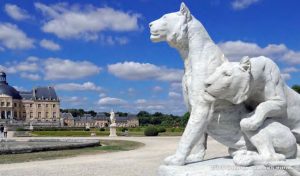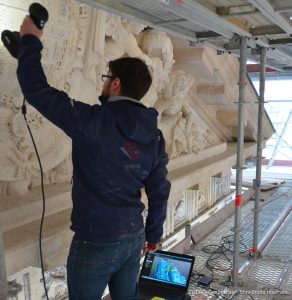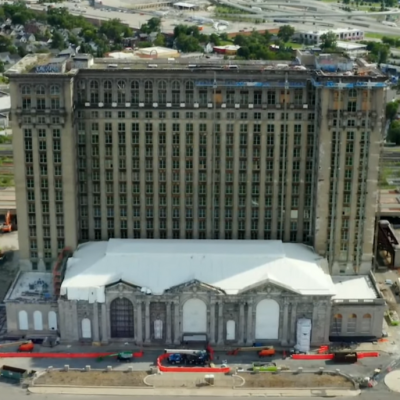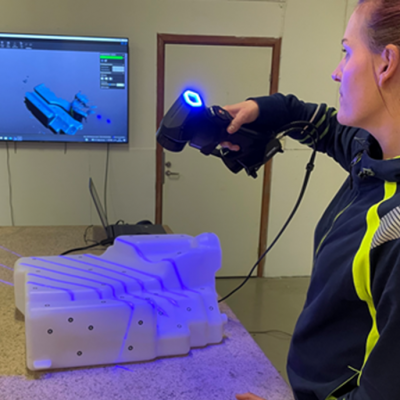December 23, 2022
Creaform 3D Scanners Helped Ford Restore Michigan Central Station See the articleBuilt in the 17th century, the Vaux-le-Vicomte estate is the brainchild of three of the very best artists at the time: landscape gardener André Le Nôtre, architect Louis Le Vau and the painter-decorator Charles Le Brun. Thanks to the genius minds of these three artists, they managed to achieve the most exquisite harmony between architecture and landscape, a pioneering accomplishment throughout the whole of the 17th century. Although the artists’ creations are now part of French heritage, never would these prodigies have imagined that their works could one day, even centuries later, be reproduced by a 3d scanner!
Moreover, this historic monument of classical French architecture is absolutely impressive simply by the sheer monumentality of the palace and its communal areas. Reflecting from the mirrors of the pools are its vast gardens embellished with numerous sculptures. This work of art became the exemplary model of Europe and the inspiration even for the Palace of Versailles, which served as a residence to kings Louis XIV, Louis XV and Louis XVI.
Today, while the statues of the estate are breathtaking, they are nonetheless 110 to 360 years old. Sadly, due to constant exposure to varying weather conditions and a green environment, the condition of these statues is now affected by lichen, moss, erosion, and breakage that in turn threaten the integrity of the 61 statues of the estate. The deterioration of their structure has prompted the Chief Architect of Historical Monuments (CAHM), the Regional Directorate of Cultural Affairs (RDCA) and the De Vogüé, family, owner and manager of this private estate, to launch a campaign in order to restore this heritage and which shall be sponsored by individuals and businesses.
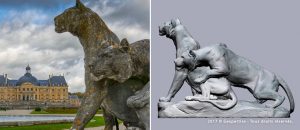
3D digitization work on the “tigers”, work of Georges Gardet (19th century).
Funding Campaign for the Preservation of the Estate
The restoration project of the Vaux-le-Vicomte estate statues emerged ten years ago from the initial need to restore 3 significantly damaged 17th-century statues created by Michel Anguier, one of Nicolas Fouquet’s favorite sculptors, founder of the estate. The requirements of this task being very expensive, they opted instead to launch a first funding campaign for these three pieces in particular. According to Alexandre de Vogüé, owner and manager of this unique estate in France, “The success of this initiative, the enthusiasm of the sponsors and the joy of making light of these rare works prompted us to further this action and include all statues of the estate, consisting of 61 works.” Because of this initial success, they started the second wave of restoration, to be planned over two years, starting in 2015.
4 restoration priorities
Today, both individuals and companies are swinging into action alongside the co-owners of the estate, to safeguard the preservation of such a masterpiece. The restoration program is estimated at 13 million euros over the next ten years and is based on four fundamental priorities:
- Preserve the garden (planting trees to restore a major natural space)
- Restore the palace (restore the transparency of the 3 arcades north and south of the palace to allow visitors to perceive, from the entry gates, the skyline of the garden despite the thickness of the building)
- Restore or acquire works of art (restore the 24 statues presented in the garden)
- Increase access and promote culture (promote access to the site for people with reduced mobility)
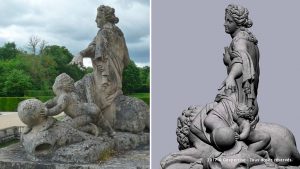
3D digitization work on the “Clemency”, work of Michel Anguier (17th century)
Keeping the memory alive in 3D
Although restoration is, first of all, performed by cleaning the works of art, it was strongly suggested to find a method that would preserve the 61 statues of the estate, without damaging them and keep their memory alive. Thanks to 3D scanning, Gexpertise’s modeling division, a specialist in the technical study of buildings and expert in 3D models worked on the estate’s digital preservation by creating a heritage archive using a hand-held 3D scanner. “In addition to cleaning the 61 statues included in the restoration project, considering this significant undertaking performed in statuary garden, the CAHM also recommended the archiving of assets in its call for tenders,” says Benoit Desriaux, project manager at Gexpertise. Indeed, the slow or accidental disappearance of fragile parts of these works makes it even more important to safeguard a memory of their original shape, as complete as possible so as to be able to reproduce a copy in the future. A contemporary and inexpensive technique is 3D digitization. It replaces plaster molding, thus avoiding physical storage and allows the production of derivative products to communicate the image.
3D digital preservation allows for:
- Create a 3D database
- Measure and analyze works
- Quantify restoration works
- Develop a heritage archive
- Make 3D reproductions
- Create a virtual museum with reconstructions in case of damage
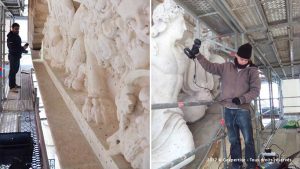
3D acquisition of statues is done with a hand-held 3D scanner, a non-contact technology that respects the work in its entirety and meshes in real time.
Non-contact technology, a simple 3d scanning process
Led by the team of Serge Giordani, curator and restorer of objects of art, and in charge of cleaning, repairing, and consolidating these stone and marble works, Benoit Desriaux, project manager and Florian Lhuillier, surveyor, have invaded the site from March to May 2016 to conduct an exceptional mission: the 3D digitization of 30 statues as planned in the first phase of this project. Then, thanks to a new philanthropic financial contribution, the second phase, and the 3D acquisition of the remaining 31 statues took place from July 2016 to January 2017. “Thanks to a Go!SCAN 3D ™ handheld scanner, a contactless technology that respects the work in its entirety and “meshes” in real time, we acquired data on each statue and then processed the raw data from the scanner,” says Florian.
The post-processing of the generated file is carried out by dedicated software in order to stop and modify the raw modeling thus obtained. “For 3D printing, the mesh of the statue must be “clean” and “watertight”, he explains. Back at the office, cleaning the mesh, filling holes, reducing noise (smoothing) and texturing were used before the finalized file export. “One day of data acquisition in the field requires, on average, one day of processing knowing that the size of the object or its level of detail can change this rule,” says Benoit, whose role also included 3D printing consultant to the sponsors. “We are not just digitally archiving, we are seeing through the whole process and helping our clients consider all uses of a 3D printer file at different scales, such as the reverse engineering of any part of the statue,” he clarifies.
The Go!SCAN 3D scanner in the hands of Gexpertise
This handheld scanner records 3D color data to represent geometry and textures in all their richness, generating a very realistic result. This tool allows survey technicians to model large objects with the accuracy of up to 0.100 mm. Automatically producing the mesh, this scanner makes it possible, right to the end of the site, to obtain visuals and be certain that the acquisition is complete, thus avoiding having to travel back and forth on the site. It meets the need for high precision and high resolution required to handle very meticulous sites such as that of Vaux-le-Vicomte.

